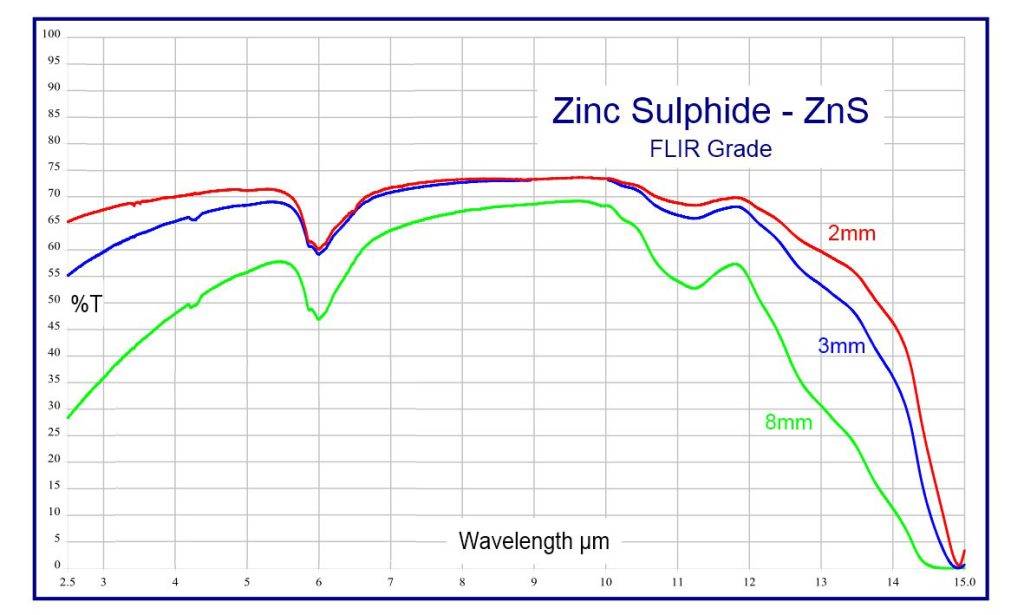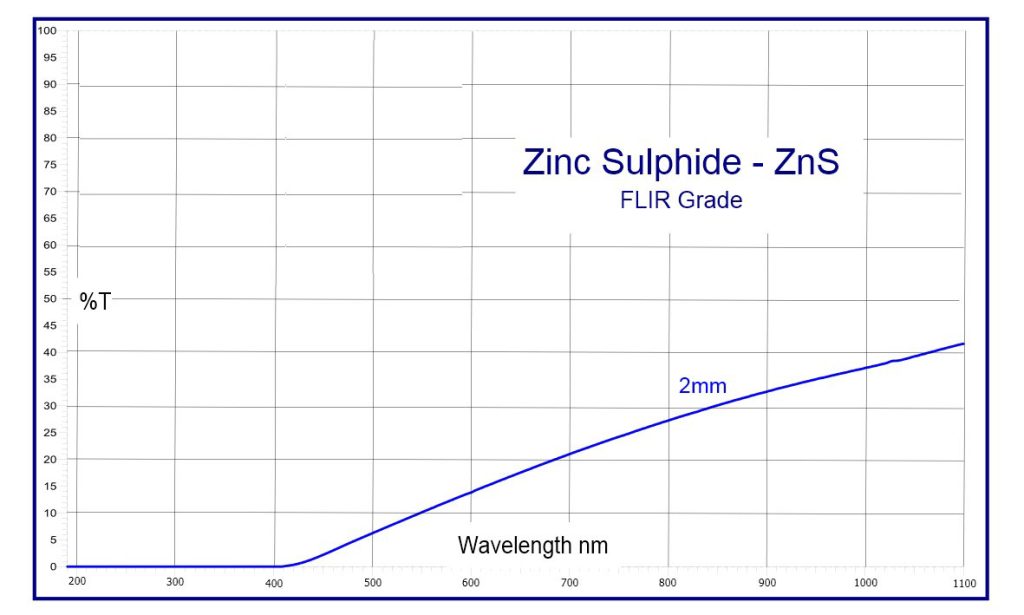Zinc sulfide (ZnS) optical window
PRODUCT CATEGORIES
INOUIRY

CVD Zinc sulfide (ZnS) is divided into two materials, one is a white multispectral material and the other is a yellow primary material. It is a chemically inert material with the characteristics of high purity, insoluble in water, moderate density and easy processing. Due to the wide transmission band (500-10000nm) of zinc sulfide (ZnS), it is widely used in the manufacture of infrared windows, fairings and infrared optical elements.
- Like zinc selenide (ZnSe), zinc sulfide (ZnS) is also a material with good refractive index uniformity and consistency. It has good image transmission performance in the 8000nm-12000nm band. The material also has high transmittance in the mid-infrared band, but as the wavelength becomes shorter, the absorption and scattering increase.
- Compared with zinc selenide (ZnSe), zinc sulfide has a low price, high hardness, and twice the fracture strength of zinc selenide, and has strong resistance to harsh environments.
Technical parameters
| Items | Parameters |
|---|---|
| Material | Zinc sulfide (ZnS) |
| Processable shapes | circular, rectangular, polygonal and other shapes |
| Size range | 3mm-500mm ± 0.1mm |
| Thickness | 0.05-50mm |
| Center deviation | 3′(we can process to 30 ″with high precision) |
| Parallelism | less than 20″ |
| Surface accuracy | Reflective PV better than 1/4λ, transmissive PV better than 1/10λ |
| Surface quality | 10-5 20-10 40-20 60-40 |
| Surface roughness | less than 5nm |
| Effective caliber | ≥90% |
| Coating | According to the custom requirements |
spectral curve (coating before)


Physical and chemical properties of zinc sulfide ZnS
| CVD Zinc Sulfide ZnS | Multi-spectrum CVD Zinc Sulfide ZnS | |
|---|---|---|
| Density (g/cm3) | 4.09 | 4.09 |
| Melting point (℃) | 1827 | 1827 |
| Resistivity Ω.CM | ~10^12 | ~10^13 |
| Chemical purity (%) | 99.9996 | 99.9996 |
| Thermal expansion coefficient (1/℃) | 6.6*10^-6@273K | 6.3*10^-6@273K |
| 7.3*10^-6@373K | 7.0*10^-6@373K | |
| Thermal conductivity (J/k.m.s) | 16.7@298K | 27.2@298K |
| Heat capacity (J/g.k) | 0.469@298K | 0.515@298K |
| Knoop hardness (kg/mm2) | 200-235 | 160 |
| Bending strength (MPa) | 103 | |
| Young's modulus(GPa) | 74.5 | 74.5 |
| Poisson's ratio | 0.29 | 0.28 |
Optical properties of zinc sulfide ZnS
| CVD Zinc Sulfide ZnS | Multi-spectrum CVD Zinc Sulfide ZnS | |
|---|---|---|
| Transmission wavelength range | 1000nm-14000nm | 370nm-14000nm |
| Refractive index inhomogeneity (ΔN/N) | <7.3*10^-4@10600nm | <0.2*10^-4@632.8nm |
| Absorption coefficient (1/cm) | 0.2@10600nm | 0.2@10600nm |
| Thermo-optic coefficient, dn/dT (1/K, 298-358K) | 4.6*10^-5@1150nm | 5.43*10^-5@632.8nm |
| 4.3*10^-5@3390nm | 4.21*10^-5@1150nm | |
| 4.1*10^-5@10600nm | 3.87*10^-5@3390nm |
Changes in refractive index of zinc sulfide material with wavelength (CVD zinc sulfide 20°C)
| Wavelength (nm) | Refractive index (n) | Wavelength (nm) | Refractive index (n) |
|---|---|---|---|
| 620 | 2.355 | 9800 | 2.203 |
| 1000 | 2.292 | 10600 | 2.192 |
| 3800 | 2.253 | 11400 | 2.180 |
| 5000 | 2.246 | 12200 | 2.167 |
| 7000 | 2.232 | 13800 | 2.132 |
| 9000 | 2.212 | 14200 | 2.126 |
Variation of refractive index with wavelength (Multi-spectrum CVD zinc sulfide 20°C)
| Wavelength (nm) | Refractive index (n) | Wavelength (nm) | Refractive index (n) |
|---|---|---|---|
| 400 | 2.545 | 8000 | 2.223 |
| 1010 | 2.292 | 9000 | 2.213 |
| 2060 | 2.264 | 10000 | 2.201 |
| 3500 | 2.255 | 11250 | 2.183 |
| 4500 | 2.250 | 12000 | 2.171 |
| 5000 | 2.247 | 13000 | 2.153 |
Window Materials Quick Guide
| Wavelength range | Window material |
|---|---|
| 180 nm - 8.0 μm | Calcium Fluoride CaF2 |
| 185 nm - 2.1 μm | UV Fused Silica |
| 200 nm - 5.0 μm | Sapphire |
| 200 nm - 6.0 μm | Magnesium fluoride MgF2 |
| 600 nm - 16 µm | Zinc Selenide ZnSe |
| 1.9 - 16 μm | Germanium single crystal Ge |
| 2 - 5 μm | Barium fluoride BaF2 |
In addition, We can customize the optical window according to customer requirements or drawings.
For details, please consult:
Related Products
No products were found matching your selection.
